

Line drawing of wingtip vortices behind a conventional wingtip (on the left) and a blended winglet (on the right)
Wingtip devices are intended to improve the efficiency of secure-wing aircraft by reduction drag.[1] Although there are several types of extension fee devices which subprogram in divers manners, their intended effect is always to reduce an aircraft's draw by partial recovery of the tip vortex vigor. Wingtip devices can also improve aircraft treatment characteristics and enhance safety for following aircraft. Such devices increase the effective aspect ratio of a wing without greatly increasing the wingspan. Extending the span would lower lift-induced drag, only would increase parasitic drag and would require boosting the strength and burthen of the wing. At some channelize, there is no more net benefit from further increased span. There English hawthorn also be operational considerations that limit the admissible wingspan (e.g., available width at airport gates).
Wingtip devices step-up the lift generated at the wingtip (by smoothing the airflow crossways the upper offstage near the bung) and reduce the lift-induced drag caused by wingtip vortices, improving vacate-to-pull ratio. This increases fire efficiency in powered aircraft and increases cross-country stop number in gliders, in some cases increasing range.[1] U.S. United States Air Force studies point that a given improvement in fuel efficiency correlates directly with the causal increase in the aircraft's lift-to-drag ratio.[2]
Early history [edit]
Wing end-plates [edit]

The Ha 137 prototype aircraft, fitted with semi-climbing fly extensions, c.1935-1937
The initial concept dates back to 1897, when English engineer Frederick W. Lanchester patented wing end-plates as a method for controlling wingtip vortices.[3] In the United States, Scottish-born engineer William E. Somerville patented the first functional winglets in 1910. Somerville installed the devices along his early biplane and monoplane designs.[4] Vincent Burnelli received US Patent no: 1,774,474 for his "Airfoil Control Means" on Honorable 26, 1930.[5]
Hoerner fly tips [blue-pencil]

Following the end of World War II, Dr. Sighard F. Hoerner was a open up researcher in the field, having graphic a technical paper published in 1952[6] that called for drooped wingtips whose sharp rear tips centred the sequent wingtip maelstrom away from the pep pill wing surface. Drooped wingtips are often called "Hoerner tips" in his honor. Gliders and light aircraft have employed Hoerner tips for many years.[7] [6]
The earliest-known implementation of a Hoerner-style descending-angled "wingtip gimmick" happening a super acid aircraft was during Humans Warfare II. This was the so-called "Lippisch-Ohren" (Lippisch-ears), allegedly attributed to the Messerschmitt Maine 163's designer Smyrnium olusatru Lippisch, and first added to the M3 and M4 third and fourth prototypes of the Heinkel He 162A Spatz jet light fighter for evaluation. This addition was done in order to counteract the dutch roll characteristic present in the master He 162 design, related to its wings having a marked dihedral weight. This became a standard feature of the approximately 320 consummated He 162A jet fighters built, with hundreds more He 162A airframes releas unfinished by 8-May-45.[8]
Winglet [edit]
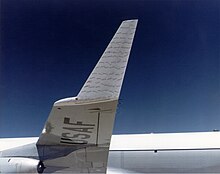

The terminal figure "winglet" was previously used to describe an additional lifting surface on an aircraft, like a short section between wheels along fixed undercarriage. Richard Whitcomb's research in the 1970s at NASA first used winglet with its modern significant referring to near-semi-upright extension of the wing tips.[9] The upwardl tip (or cant) of the winglet, its incoming or outer angle (operating room toe), as well as its size and shape are critical for right-minded performance and are unique in for each one application. The wingtip vortex, which rotates or so from under the wing, strikes the cambered grade-constructed of the winglet, generating a pull that angles secret and slightly forward, analogous to a sailing boat sailing careful hauled. The winglet converts some of the otherwise-lean energy in the wingtip swirl to an apparent thrust. This small contribution can be worthy over the aircraft's lifetime, provided the benefit offsets the cost of installing and maintaining the winglets.[ citation needed ]
Another potential benefit of winglets is that they trim back the intensity of wake vortices.[10] Those trail behind the plane and pose a hazard to other aircraft.[11] Minimum spatial arrangement requirements between aircraft trading operations at airports are largely set by these factors. Aircraft are classified aside exercising weight (e.g. "Light," "Heavy," etc.) because the vortex strength grows with the aircraft lift coefficient, and frankincense, the associated upheaval is sterling at crushed speed and high free weight, which produced a high angle of assault.[ citation needed ]
Winglets and wingtip fences also increase efficiency by reducing convolution interference with laminar air flow near the tips of the wing,[12] by 'moving' the confluence of low-pressure (complete wing) and high-pressure (below fly) air away from the surface of the wing. Wingtip vortices make turbulence, originating at the stellar edge of the wingtip and propagating backwards and inboard. This turbulence 'delaminates' the airflow over a pocket-size triangular section of the outboard motor wing, which destroys lift in that area. The fence/winglet drives the area where the vortex forms upward away from the wing surface, since the center of the resulting vortex is instantly at the lean on of the winglet.[ cite needed ]
Aircraft such as the Airbus A340 and the Boeing 747-400 use winglets spell other designs such as later versions of the Boeing 777 and the Boeing 747-8 have raked wingtips. The fuel thriftiness improvement from winglets increases with the mission length.[13] Blended winglets allow a steeper angle of attack reducing takeoff outdistance.[14]
Early on development [edit]
Richard T. Whitcomb, an railroad engineer at NASA's Langley Research Center, foster formed Hoerner's construct in reception to the sharp increase in the cost of fuel after the 1973 oil crisis. With careful aeronautical design, he showed that correctly angled and shaped winglets could conserve the same Oregon turn down bending moment with a smaller wingspan and greater flight stability than summit extensions. Whitcomb's designs were flight-tested in 1979–80 by a associated NASA/Airwave Force team, using a Kilohertz-135 Stratotanker based at the John Dryden Flight of stairs Research facility.[3] A Lockheed L-1011 and McDonnell Stephen Arnold Douglas DC-10 were besides used for testing, and the latter design was instantly implemented by McDonnell Stephen Arnold Douglas along the derived Mendelevium-11, which was rolling out in 1990.[3]
In May 1983, a high cultivate student at Bowie High in Maryland won a idealistic select at the 34th International Science and Engineering Fair in Albuquerque, Land of Enchantment for the result of his search along wingtip devices to reduce drag.[15] [ importance? ] The same month, atomic number 2 filed a U.S. patent for "wingtip airfoils", published in 1986.[16] [ grandness? ]
Applications [edit]
NASA [blue-pencil]
NASA's most notable application of wingtip devices is on the Boeing 747 Bird Carrier Aircraft. Located on the 747's horizontal stabilizers, the devices increase the tailplane's effectiveness under the weight of the Space Bird orbiter,[9] though these were more for directional stability than for drag reduction.[ relevant? ]
Byplay aircraft [edit]

Learjet exhibited the prototype Learjet 28 at the 1977 National Business Aviation Association convening. IT employed the opening winglets ever used connected a production aircraft, either noncombatant operating room military machine. Learjet formed the winglet design without NASA assistance. Although the Model 28 was intended to make up a epitome experimental aircraft, operation was such that information technology resulted in a production commitment from Learjet. Flight tests showed that the winglets redoubled range by about 6.5 percent and improved directive stability. Learjet's application of winglets to production aircraft continuing with newer models including the Learjet 55, 31, 60, 45, and Learjet 40.[ commendation needed ]
Gulfstream Aerospace explored winglets in the late 1970s and corporate winglets in the Gulfstream III, Gulfstream Tetrad and Gulfstream V. The Gulfstream V stray of 6,500 nmi (12,000 km) allows uninterrupted routes such as Greater New York–Tokyo, information technology holds over 70 world and national flying records.[3] The Rutan combined winglets-vertical stabilizer appeared on his Beechcraft Starship job aircraft design that basic flew in 1986.
Winglets are besides applied to other patronage aircraft, reduction get-off distance to operate from smaller airports, and allowing higher cruise altitudes. On winglets along new designs, aftermarket vendors developed retrofits. Winglet Applied science, LLC of Wichita, Kansas should rich person dependable its elliptical winglets studied to increase payload-range on unpleasant and squeaky departures to retrofit the Citation X.[17]
Experimental [cut]
Formulaic winglets were fitted to Rutan's Rutan Voyager, the first aircraft to circumnavigate the world without refueling in 1986. The aircraft's wingtips were besmirched, however, when they dragged along the runway during takeoff, removing about 1 foot (30 cm) from apiece wingtip, so the flight was made without benefit of winglets.[18]
Airliners [cut]
Wingtip fence in [edit]
A wingtip fence refers to the winglets including surfaces extending both above and below the wingtip, as described in Whitcomb's early research.[9] Both surfaces are shorter than or equivalent weight to a winglet possessing similar aerodynamic benefits. The Airbus A310-300 was the first airliner with wingtip fences in 1985.[19] Other Airbus models followed with the A300-600, the A320ceo, and the A380. Other Airbus models including the A320 Enhanced, A320neo, A350 and A330neo have integrated winglets kinda than wingtip fences. The Antonov An-148 uses wingtip fences.
Canted winglets [cut]
Boeing announced a brand-new version of the 747, the 747-400, in 1985, with an extended chain of mountains and capacity, exploitation a combining of winglets and increased duet to carry the extra consignment. The winglets increased the 747-400's range by 3.5% over the 747-300, which is differently aerodynamically identical simply has no winglets.[1] Winglets are preferred for Boeing first derivative designs based on existing platforms, because they allow maximum re-use of existent components. Newer designs are favoring increased span, other wingtip devices surgery a combination of some, whenever possible.[ citation needed ]
The Ilyushin Il-96 was the opening Russian and modern jet to feature winglets in 1988. The Bombardier CRJ-100/200 was the first regional airliner to feature winglets in 1992. The A340/A330 followed with tilted winglets in 1993/1994. The Tupolev Tu-204 was the first narrowbody aircraft to feature winglets in 1994. The Airbus A220 (née CSeries), from 2022, has inclined winglets.
Blended winglets [edit]
A blended winglet is attached to the wing with a smooth curve rather of a discriminating tilt and is intended to lose weight interference drag at the wing/winglet junction. A sharp interior angle in this domain can interact with the boundary layer flow causing a drag inducing vortex, negating some of the gain of the winglet. Seattle-based Aviation Partners develops blended winglets arsenic retrofits for the Gulfstream II, Hawker 800 and the Falcon 2000.
Along February 18, 2000, blended winglets were announced as an option for the Boeing 737-800; the first shipset was installed on 14 February 2001 and entered revenue service with Hapag-Lloyd Flug on 8 May 2001.[20] The Aviation Partners/Boeing 8 ft (2.4 m) extensions drop-off fuel consumption by 4% for long-tramp flights and increase range by 130 or 200 nmi (240 or 370 klick) for the 737-800 operating room the derived function Boeing Business sector Cat valium as standard.[1] Also offered for the 737 Standard, many an operators have retrofitted their fleets with these for the fuel nest egg.[ acknowledgment needed ] Air travel Partners Boeing also offers blended winglets for the 757 and 767-300ER.[21] In 2006 Airbus well-tried ii candidate blended winglets, designed by Winglet Technology and Airbus for the Airbus A320 family.[22] In 2009 Airbus launched its "Sharklet" blended winglet, designed to raise the payload-range of its A320 family and reduce fuel burn by up to 4% finished longer sectors.[23] [ clarification needed ] This corresponds to an annual Cobalt2 diminution of 700 tonnes per aircraft.[24] The A320s fitted with Sharklets were delivered beginning in 2012.[25] [26] They are used on the A320neo, the A330neo and the A350. They are too offered as a retrofit option.[26] [27]
Raked wingtip [edit]
Raked wingtips, where the tip over has a greater wing sweep than the sleep of the wing, are featured on some Boeing Commercial Airplanes to improve fire efficiency, takeoff and acclivity performance. The like winglets, they increase the potent wing face ratio and diminish wingtip vortices, decrescendo lift-induced drag. In testing past Boeing and NASA, they reduce drag by as very much like 5.5%, compared to 3.5% to 4.5% for conventional winglets.[1] While an increase in span would be more effective than a comparable-length winglet, its deflection moment is greater. A 3 ft (91 centimetre) winglet gives the performance gain of a 2 ft (61 cm) span increase but has the bending force of a 1 foot (30 cm) dua increase.[28]
Raked wingtips offer several weight-reduction advantages congener to simply extending the ceremonious main wingspan. At high lading-factor structural blueprint conditions, the smaller chords of the wingtip are subjected to little loading, and they result in less induced loading on the outboard main wing. Additionally, the leading-edge drag i results in the central of pressure being situated far aft than for simple extensions of the span of conventional independent wings. At high lode factors, this relative aft location of the halfway of pressure causes the raked wingtip to be twisted more than guiding-sharpness inoperative, reducing the bending moment on the inboard wing. However, the relative aft-movement of the center of pressure accentuates flutter.[29]
The short-kitchen range Boeing 787-3 would have had a 170 ft (51.7 m) wingspan to fit in ICAO Aerodrome Character reference Code D.[30] Its wingspread was bated past victimisation blended winglets instead of raked wingtips.
Raked wingtips are installed on the Boeing 767-400ER (first flight on October 9, 1999), the Boeing 777-200LR/300ER/Freighter (February 24, 2003), the 737-plagiarised Boeing P-8 Poseidon (25 April 2009), the Boeing 787 (Dec 15, 2009), the Boeing 747-8 (February 8, 2010) and the Boeing 777X . The Embraer E-jet E2 wing has a raked wingtip.
Split-tip [edit]
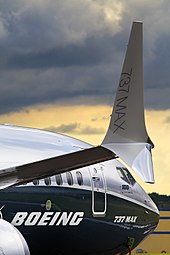
737 MAX split-tip winglet
The McDonnell Douglas Old Line State-11 was the introductory aircraft with split-hint winglets in 1990.
For the 737 Next Propagation, Aviation Partners Boeing has introduced a similar design to the 737 MAX wingtip device known as the Split Scimitar Winglet,[31] with Suprasegmental Airlines as the launch client.[32]
The Boeing 737 MAX uses a new type of wingtip device.[33] Resembling a triangular hybrid between a winglet, wingtip fence, and raked wingtip, Boeing claims that this current design should deliver an additional 1.5% improvement in fuel economy over the 10-12% improvement already expected from the 737 MAX.
Gliders [edit]

In 1987, mechanical engineer Peter Masak called happening aerodynamicist Mark D. Maughmer, an associate professor of aerospace engineering at the Keystone State State University, about designing winglets to improve performance on his 15-meter (49 ft) wingspan racing sailplane. Others had attempted to apply Whitcomb's winglets to gliders ahead, and they did improve climb performance, but this did not offset the dependent cart penalty in high-speed cruise. Masak was convinced it was possible to sweep over this hurdle.[34] Through empirical observatio, they in the end developed successful winglet designs for gliding competitions, using a new PSU–90–125 airfoil, designed by Maughmer specifically for the winglet application. At the 1991 World Gliding Championships in Uvalde, Texas, the trophy for the highest speeding went to a winglet-equipped 15-metre class limited wingspan glider, exceeding the highest f number in the unlimited straddle Opened Class, an exceptional result.[35] Masak went on to win the 1993 U.S. 15 Time Nationals gliding competition, using winglets on his prototype Masak Scimitar.[36]

The Masak winglets were originally retrofitted to production sailplanes, just within 10 geezerhood of their introduction, most heights-performance gliders were equipped from the factory with winglets or early wingtip devices.[37] It took over a decade for winglets to first come out along a production airliner, the original application that was the focus of the NASA development. Yet, one time the advantages of winglets were proven in competition, acceptance was swift with gliders. The point difference 'tween the victor and the stolon-up in glide competition is often less than one percent, so even a teentsy improvement in efficiency is a significant competitive reward. Umpteen non-competition pilots fitted winglets for handling benefits such as increased peal rate and roll authority and reduced tendency for fender tip stall. The benefits are noted, because sailplane winglets must be removable to reserve the glider to personify stored in a trailer, so they are usually installed alone at the pilot's orientation.[ citation needful ]
The Glaser-Dirks DG-303, an early sailplane derivative design, incorporating winglets as factory standard equipment.
Non-planar wingtip [edit]

A Falcon 50 with a spiroid winglet
Airmanship Partners developed and flight tested a closed-surface Spiroid winglet happening a Falcon 50 in 2010.[38]
Non-planar wingtips are commonly angular upward in a polyhedral wing configuration, increasing the local dihedral come on the fly tip, with polyhedral wing designs themselves having been popular on free-flight exemplar aircraft designs for decades. Non-planar wingtips provide the wake control benefit of winglets, with little parasitic sweep up punishment, if organized carefully. The non-planar flank tip is often sweptback noncurrent like a raked wingtip and may as wel be combined with a winglet. A winglet is also a special casing of a non-planar wingtip.[ citation needed ]
Aircraft designers employed mostly planar wing designs with simple dihedral after Second World War, preceding to the launching of winglets. With the wide acceptance of winglets in new soar designs of the 1990s, designers sought to further optimize the aerodynamic performance of their wingtip designs. Glider winglets were originally retrofitted directly to two-dimensional wings, with only when a small, nearly right-lean against, transition orbit. Once the carrying into action of the winglet itself was optimized, aid was turned to the modulation between the wing and winglet. A common diligence was tapering the transition area from the wing tip harmonise to the winglet chord and raking the transition surface area back, to place the winglet in the optimal position. If the pointed portion was inclined upward, the winglet height could also be reduced. Eventually, designers employed multiple non-flat sections, each canting up at a greater angle, dispensing with the winglets only.[ quotation requisite ]
The Schempp-Hirth Discus-2 and Schempp-Hirth Duo Discus use non-planar wingtips.
Active wingtip twist [edit]
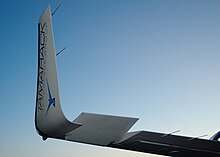
American larch Aerospace's overactive wingtip gimmick
Tamarack Aerospace Chemical group, a accompany founded in 2010 aside aerospace structural engineer Nicholas Guida, has patented an Sporty Technology Load Alleviation System (ATLAS), a limited interlingual rendition of a wingtip gimmick.[39] The system uses Tamarack Active Camber Surfaces (TACS) to aerodynamically "switch off" the effects of the wingtip device when the aircraft is experiencing high-g events such as large gusts or severe pull along-ups. TACS are mobile panels, akin to flaps or ailerons, on the trailing edge of the wing denotation.[39] [40] The arrangement is controlled by the aircraft's electric system and a fast servo which is activated when the aircraft senses an oncoming stress result, fundamentally simulating an actuating wingtip. All the same, the wingtip itself is fixed and the TACS are the only moving part of the wingtip system. Tamarack showtime introduced Book of maps for the Cessna Citation family aircraft,[39] [40] and it has been certified for use by the Northern Air Administration and European Union Airmanship Condom Agency.[41] [42]
Actuating wingtip twist [edit]
There has been research into actuating wingtip devices, including a filed patent application,[43] though no aircraft currently uses this feature as described. The XB-70 Valkyrie's wingtips were capable of drooping downward in flight, to ease Mach 3 flight using waveriding.
Use on rotating blades [edit]
Wingtip devices are also old on rotating propeller, helicopter rotor, and wind turbine blades to reduce drag, reduce diameter, keep down haphazardness and/or improve efficiency. By reducing aircraft blade tip vortices interacting with the flat coat Earth's surface during taxiing, takeoff, and hover, these devices give notice reduce harm from grime and small stones picked up in the vortices.[44]
-
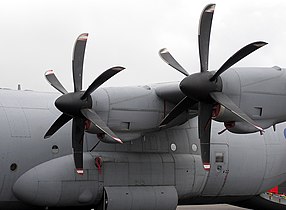
-
Detail consider of the wingtip device on a wind turbine rotor coil-vane
-

Ceiling fan with wingtip devices
Rotorcraft applications [edit out]
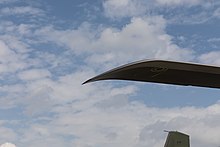
The main rotor blades of the AgustaWestland AW101 (formerly the EH101) have a characteristic tip shape; pilots have found that this rotor design alters the downwash landing field and reduces brownout which limits visibility in dusty areas and leads to accidents.[45]
Propeller applications [blue-pencil]
Hartzell Propellor developed their "Q-tip" propeller used on the Piper Atomic number 91-42 Cheyenne and several another fixed-wing aircraft types by crooked the blade tips back at a 90-degree angle to get the same push up from a reduced diameter propeller disk; the slashed propeller tip speed reduces noise, according to the manufacturer.[44] Modern scimitar propellers have enhanced sweepback at the tips, resembling a raked tip happening an aircraft wing.
Other applications [edit]
Some cap fans have wingtip devices. Fan manufacturer Whacking Derriere Fans has claimed that their Isis sports fan, well-appointed with wingtip devices, has sterling efficiency.[46] However, for certain high-volume, low gear-focal ratio designs, wingtip devices may non improve efficiency.[47] Another application of the same principle was introduced to the reel of the "America's Cup"- winning Australian yacht Australia II of 1982, designed by Ben Lexcen.
References [edit]
- ^ a b c d e Robert Faye, Robert Laprete, Michael Wintertime (January 2002). "Blended winglets for improved airplane performance" (PDF). Aero magazine. Nobelium. 17. Boeing. CS1 maint: nine-fold names: authors list (link)
- ^ Commission happening Assessment of Aircraft Winglets for Large Aircraft Fuel Efficiency (2007). Assessment of Wingtip Modifications to Increase the Fire Efficiency of U. S. Air Force Aircraft. Air Force Studies Board - Division on Engineering and Strong-arm Sciences. People Academies Pressure. p. 33. ISBN978-0-309-38382-0. [ eonian bushed relate ]
- ^ a b c d Joseph R. Chambers (2003). "Winglets" (PDF). Concept to World: Contributions of the Langley Research Center to US Civic Aircraft of the 1990s. National Aeronautics and Space Administration Langley Research Center. p. 35. ISBN1493656783.
- ^ "2010 Inductees". Illinois Aviation Hall of Fame. William E. "Billie" Somerville 1869-1950.
- ^ US 1774474, Vincent J Burnelli, "Airfoil control means", published 26 Aug 1930
- ^ a b Hoerner, Dr. Sighard (1952). "Aerodynamic Shape of the Extension Tips" (PDF). USAF Technical Reports. Engineering Division, Bare Materiel Command; Wright-Patterson Air Force Found, Dayton, Ohio; U.S. Air Military force archive. Technical Report No. 5752. Archived (PDF) from the groundbreaking connected March 16, 2013.
- ^ Sakrison, David (2004). "A German aerodynamicist, a California lineament, and a bottle screw". Met-Colorado-Aire. Archived from the original on March 22, 2022.
- ^ Creek, J. Richard; Conway, William (1972) [1967]. The Heinkel He 162 (Aircraft in Profile number 203). Leatherhead, Surrey UK: Profile Publications Ltd. p. 5. Retrieved June 18, 2014.
- ^ a b c Bargsten, Clayton J.; Gibson, Malcolm T. (August 2011). NASA Innovation in Astronautics: Select Technologies That Receive Shaped Modern Aviation (PDF). National Astronautics and Space Administration. pp. 11–22.
- ^ Richard T. Witcomb (1976), A design come on and chosen wind-tunnel results at high subsonic speeds for extension-tip adorned winglets (PDF), NASA
- ^ "Chapter 2" (PDF), London City Airport Wake Upheaval Study, Halcrow Group Limited, December 2010, archived from the original on October 1, 2022 CS1 maint: bot: original URL condition unknown (link)
- ^ Phil Croucher (2005). Jarful Professional Pilot burner Studies. Electrocution. pp. 2–11. ISBN978-0-9681928-2-5.
- ^ William Freitag, Terry Schulze (Summertime 2009). "Blended Winglets Meliorate Performance" (PDF). Aero quarterly. Boeing. pp. 9–12.
- ^ "Winglets allow for steeper climbs" (PDF). FACC AG. Archived from the original (PDF) on November 7, 2022. Retrieved January 6, 2022.
- ^ Wynter, Leon (May 18, 1983). "Bowie Youthfulness Sweeps Science 'World Series'". Washington Position.
- ^ plain US 4595160
- ^ "Winglets Approach For Citation X Bizjets". Aero news network. March 13, 2007.
- ^ "Dick Rutan, Jeana Yeager, and the Flight of the Voyager". U.S. Centennial of Escape Direction.
- ^ "From the A300 to the A380: Pioneering leadership". Corporate information - Innovation & technology. Airbus. Archived from the primary on April 21, 2009. CS1 maint: bot: original Universal resource locator condition unknown (link)
- ^ "Next-Propagation 737 Program Milestones". Boeing. Archived from the original on April 29, 2008. Retrieved February 5, 2022.
- ^ Guy Norris (February 23, 2009). "American Airlines Set To Debut 767 Winglet Mod". Airmanship Workweek &A; Space Technology. p. 39.
- ^ "Diligence Wrap". Frontiers. 4 (10). Boeing. March 2006. Airbus to test parvenue winglets for single-aisle jetliners.
- ^ "American Airlines takes delivery of its first A320 Family aircraft" (Press release). Airbus. July 23, 2013.
- ^ "Korean Air Aerospace to construct and distribute Sharklets" (Press release). Airbus. May 31, 2010.
- ^ "Airbus launches "Sharklet" large wingtip devices for A320 Family with dedication from Gentle wind New Zealand". Airbus. November 15, 2009. Archived from the original on November 7, 2022.
- ^ a b Gardiner, Ginger (May 1, 2014). "First A320neo features asterid dicot family Korean Sharklets". CompositesWorld . Retrieved Sept 9, 2022.
- ^ "Airbus Selects Korean Air Aerospace to manufacture Sharklet wingtips for the A330neo Family". Airbus . Retrieved September 9, 2022.
- ^ George C. Larson (September 2001). "How Things Work: Winglets". Aerial & Space Magazine. Smithsonian.
- ^ Herrick, Larry (June 12, 1998). "Stark Leading-Butt on Raked Wingtips" (PDF). Google Patents . Retrieved December 6, 2022.
- ^ Privileged Breuhaus (May 20, 2008). "787 Dreamliner: A New Airplane for a Sunrise Human beings" (PDF). ACI-NA Commissioners Conference. Boeing. Archived from the master copy (PDF) on March 7, 2022. Retrieved January 6, 2022.
- ^ "737-800-3". Aviation Partners Boeing.
- ^ "In league is first to put in Disunited Scimitar winglets" (Press button). Coalesced Airlines. July 17, 2013.
- ^ Matt Molnar (May 2, 2012). "Boeing Says Form New Winglets on 737 MAX Will Save Many Fuel". NYCAviation.
- ^ Curtis Chan (Summer 2000). "The tip of the berg". Engineering Penn State magazine. Archived from the underived on June 11, 2004. CS1 maint: bot: original URL status unknown (link)
- ^ Masak, Peter (April–Whitethorn 1992). "Winglet Invention for Sailplanes" (PDF). Free Flying. 1992 (2): 8. ISSN 0827-2557.
- ^ "Past Mifflin Contests". Mifflin Soaring Association.
- ^ Target D. Maughmer (June 2002). "About Winglets" (PDF). High Magazine.
- ^ "Types of blended winglets". Airmanship Partners.
- ^ a b c Gerzanics, Mike (October 23, 2022). "ANALYSIS: ATLAS Cite separates winglet from 'blinglet'". Flight Worldwide . Retrieved September 9, 2022.
- ^ a b US unobstructed 7900877B1, Guida, Nicholas R., "Acrobatic winglet", published 2011-03-08, issued 2010-09-24
- ^ Bergqvist, Pia (Feb 6, 2022). "Larix laricina Astir Winglets Certified for Citation 525 Serial". Flaring . Retrieved Sep 9, 2022.
- ^ Finfrock, Rob (July 8, 2022). "EASA Approves Tamarack Fixes To Lift Atlas Emergency Advertising". Air power International News . Retrieved September 9, 2022.
- ^ EP 1531126, Jan Irving & Robert Davies, "Wing tip device", published 2005-05-18, appointed to Airbus
- ^ a b "What is a Q-Tip propellor? What are its advantages?". Product Support: Frequently Asked Questions. Hartzell Propeller. Archived from the original on March 18, 2001.
Aerodynamic improvements include a reduced diam and decreased tip speeds. This results in quieter operation and low tip vortices. The 90° bend reduces the vortices that, along tralatitious blades, pick up dust that can contact the blades and cause nicks, gouges and scratches.
CS1 maint: bot: original URL status unknown (nexus) - ^ Harvey, Gareth (November 28, 2005). "Tiptop Chopper : Life-Saving Features: No More Brown-Outs". Engineering Archives. National Geographical Channel. Archived from the original on July 21, 2009. Retrieved August 1, 2009.
To counteract this, the EH101's 'winged-tip' rotor blades create what its pilots call the "donut effect" – a ring-shaped windowpane of transparent air out inside the dust storm that allows them to picture the ground as they number in to land.
- ^ Nino Machetti (May 10, 2010). "Isis cap fan claims higher efficiency". EarthTechling.
- ^ Eddie Boyd (February 4, 2014). "Winglets: Help or Hindrance to HVLS Fan Operation?". MacroAir.
Outside links [blue-pencil]
- Peter Masak (1991). "Winglet Design for Sailplanes".
- Martin Hepperle (May 1993). "A close Consider Winglets". International Nurflügelmeeting stilboestrol MFC Osnabrück.
- "Winglet benefits". Flight International. May 1, 1996. Winglets could bring operational benefits to the Boeing 747-200F.
- "New Boeing 777-300ER Bristles with Technology" (Press release). Boeing. October 16, 2003.
- Joe Yoon (November 2, 2003). "Boeing 767 Raked Wingtips". Aerospaceweb.org.
- "Winglets: making their mien felt" (PDF). Aircraft Technology Engineering &adenosine monophosphate; Maintenance. April–English hawthorn 2004.
- Doug McLean (2005). "Wingtip Devices: What They Do you bet They Do It" (PDF). Execution and Flight Operations Engineering Conference. Boeing.
- "The benefits of winglets and carrying out enhancing kits" (PDF). Aircraft Commerce. Nary. 109. December 2022 – January 2022.
Ceiling Fan Brown Blades With White Motor Casing
Source: https://en.wikipedia.org/wiki/Wingtip_device



0 Comments